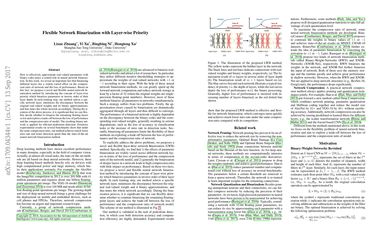Flexible Network Binarization with Layer-wise Priority
How to effectively approximate real-valued parameters with binary codes plays a central role in neural network binarization. In this work, we reveal an important fact that binarizing different layers has a widely-varied effect on the compression ratio of network and the loss of performance. Based on this fact, we propose a novel and flexible neural network binarization method by introducing the concept of layer-wise priority which binarizes parameters in inverse order of their layer depth. In each training step, our method selects a specific network layer, minimizes the discrepancy between the original real-valued weights and its binary approximations, and fine-tunes the whole network accordingly. During the iteration of the above process, it is significant that we can flexibly decide whether to binarize the remaining floating layers or not and explore a trade-off between the loss of performance and the compression ratio of model. The resulting binary network is applied for efficient pedestrian detection. Extensive experimental results on several benchmarks show that under the same compression ratio, our method achieves much lower miss rate and faster detection speed than the state-of-the-art neural network binarization method.
PDF Abstract

